2. 林木资源高效生产全国重点实验室,100083,北京;
3. 北京农业职业学院,102442,北京;
4. 北京市十三陵林场管理处,102200,北京
中国水土保持科学  2024, Vol. 22 2024, Vol. 22  Issue (3): 82-92. DOI: 10.16843/j.sswc.2024026 Issue (3): 82-92. DOI: 10.16843/j.sswc.2024026 |
我国是世界上水资源匮乏的国家之一。近年来,大气增温和人类不合理活动使水资源更加短缺,我国干旱土地面积增加,水土流失严重,林地水资源的科学管理和高效利用成为目前讨论的关键问题[1-3]。植物蒸腾耗水是植被水分利用的主要形式之一,在气体交换、运输养分和适应热胁迫方面有重大贡献[2],通过测算植物蒸腾耗水计算其生态需水,可为植被恢复工程提供参考。
目前,对于造林树种蒸腾耗水的研究多集中于乔木树种,基于乔木树种蒸腾与树干液流的探究发现二者之间具有显著线性相关关系[4-8],树干液流测定可以准确估计单株植被蒸腾量和蒸腾过程[9-11]。树干液流主要受环境因子和生物因子的调控,其中环境因子分两大类:一是驱动植物蒸腾的大气蒸发动力(包括太阳辐射、空气温度等);二是保证植物生长发育的水分供给(包括蒸气压差、土壤水分等)[12-15]。植物自身气孔导度主要通过调节气孔开闭来调控树干液流[16]。树干液流在季节与昼夜尺度的调控因子存在差异,季节尺度下树干液流主要受太阳辐射和蒸气压差调控[17-18],日尺度下太阳辐射为主要影响因子[15, 17-18]。种间树干液流速率及其调控机制也不尽相同[12-19]。因此,探明季节与昼夜尺度下树干液流的调控机制对分析植物蒸腾耗水具有重要意义。
作为北京地区典型乡土造林树种之一,黄栌(Cotinus coggygria)具有很高的观赏价值和生态效益,其生长矮小,属小乔木或灌木,生长快,根系发达,是半干旱区植被恢复的重要木本植物[20]。与乔木树种相比,小乔木树干液流日变化波动性更大,且日内液流启动、达到峰值与终值的时间更早[21]。目前,对于乔木耗水特性研究多集中于盆栽控制试验[20, 22-25],试验结果无法精确代表植物实际生长过程中的蒸腾耗水规律与对环境响应机制。本研究选取北京地区黄栌为研究对象,分别探究季节、昼夜尺度树干液流的变化规律以及对环境因子的响应,明确影响液流变化的主要环境因子,结果有助于理解环境对黄栌蒸腾的驱动规律,为未来气候变化下水土保持林的树种选择与经营管理提供科学基础。
1 研究区概况研究区位于北京市昌平区蟒山国家森林公园内人工林生态系统监测站(E 116°16′35″,N 40°15′27″),植被类型为针阔混交人工林,海拔661 m,属暖温带大陆性季风气候,年平均气温12 ℃,最低月均温为-4.1 ℃,最高月均温为25.8 ℃,多年平均降水量为500~600 mm,集中在7—8月;土壤类型主要为褐土,含砾石较多,且较黏重,土层厚度平均在30~40 cm[15]。在研究区内选取长势均匀良好的黄栌林布设20 m×20 m的样地,并在四周设置围栏,防止周边牲畜扰动(图 1)。
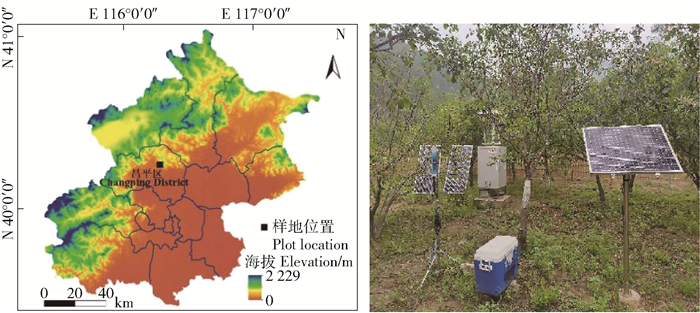
|
图 1 黄栌样地 Fig. 1 Cotinus coggygria plot |
在样地内随机选取长势良好且大小均匀的6株样树(表 1)。于2021年使用热扩散技术(TDP)测量树干液流[26-28],在样木径干1.3 m高的北侧位置,将一组探针(长度30 mm)垂直插入样株边材中,外附铝膜包裹,并用防水胶带密封铝膜与径干的连接处,防止外界物理损坏以及太阳辐射和降雨的影响[28]。采用Sap IP液流监测网络采集数据(图 1),记录间隔为15 min,每10 d定期维护仪器1次。本研究中1—3月、10—12月液流接近于0,定义为非生长季,故本研究涉及时段为2021年4—9月。
| 表 1 黄栌样树主要参数 Tab. 1 Major parameters of sample trees in Cotinus coggygria plot |
使用距样地直线距离30 m处涡度塔上的微气象观测系统对环境因子进行连续观测。空气温度Ta(air temperature, ℃)和相对湿度RH(relative humidity, %)采用空气温湿度传感器(ATMOS14, Campbell Scientific, Inc., Logan, UT, USA)观测,光合有效辐射PAR(photosynthetically active radiation, μmol/(m2·s))采用光合有效辐射仪(LI-190R, Campbell Scientific, Inc., Logan, UT, USA)观测,降雨量P(precipitation, mm)采用雨量筒(ECRN-100, Campbell Scientific, Inc., Logan, UT, USA)观测,土壤体积含水量VWC(volumetric soil water content, m3/m3)分别由样地内随机布设的3套土壤水分传感器(5TM, Campbell Scientific, Inc., Logan, USA)测定, 布设深度皆为10 cm。定期从数据采集器(CR1000, Campbell Scientific, Inc., Logan, UT, USA)拷贝环境因子的半小时数值,记录间隔为30 min,每10 d定期维护仪器1次。
2.3 数据处理 2.3.1 数据异常值剔除与插补本研究采用3倍标准差的方法去除数据异常值;对停电、仪器故障、异常数据剔除造成的数据缺失进行插补,若数据缺失时间小于2 h,采用线性内插法[29];若数据缺失时间过长,采用边际抽样分布法进行插补[30]。原始数据缺失率为4.13%。
2.3.2 液流及环境因子数据计算液流速率反映单位时间单位面积通过的液流量,计算公式如下[26-27, 31-32]
| $ J_{\mathrm{s}}=0.011\ 9\left(\frac{\Delta T_{\mathrm{m}}-\Delta T}{\Delta T}\right)^{1.231} 。$ | (1) |
式中:Js为液流速率,g/(cm2·s);ΔTm为每日温差最大值,℃;ΔT为探针间的温差,℃。
边材面积采用生长锥法获得,通过测量样木1.3 m处的胸径、木质部长度和心材长度[33],通过以下公式计算:
| $ S_{\mathrm{A}}=\frac{\pi}{4} \varPhi\left(D_{\mathrm{X}}^2-D_{\mathrm{H}}^2\right) 。$ | (2) |
式中:SA为边材面积,m2;Φ为胸径,m;DX为木质部长度,m;DH为心材长度,m。
基于边材面积,对样株液流进行加权平均,公式如下:
| $ J_{\mathrm{s}}^{\prime}=\frac{\sum\limits_1^n J_{\mathrm{s} i} S_{\mathrm{A} i}}{\sum\limits_1^n S_{\mathrm{A} i}} $ | (3) |
式中:Js′为加权平均后的液流速率,g/(cm2·s);Jsi为样地中第i棵样株的液流速率,g/(cm2·s);SAi为第i棵样株的边材面积,cm2;n为样株数量,n=6。
单位地面面积蒸腾计算公式如下:
| $ T_{\mathrm{r}}=10 J_{\mathrm{s}}^{\mathrm{d}} I_{\mathrm{SA}} $ | (4) |
式中:Tr为单位地面面积蒸腾,mm/d;Jsd为日平均液流速率,g/(cm2·d)。
| $ I_{\mathrm{SA}}=\frac{\sum\limits_1^n S_{\mathrm{A} i}}{A} $ | (5) |
式中:ISA指边材面积指数,m2/m2;SAi为样地中第i棵样株的边材面积;A为样地面积,A=400 m2。
蒸气压差由空气温度和相对湿度计算得到:
| $ \mathrm{VPD}=e-e \frac{R_{\mathrm{H}}}{100} $ | (6) |
式中:VPD为蒸气压差,kPa;RH为相对湿度,%;由空气温度计算得到,量纲为1:
| $ e=0.611 \exp \left(\frac{17.27 T_{\mathrm{a}}}{273.3+T_{\mathrm{a}}}\right) $ | (7) |
气孔导度采用彭曼公式的简化公式计算[34],公式如下:
| $ g_{\mathrm{s}}=\frac{\gamma \lambda J_{\mathrm{s}}}{\rho C_{\mathrm{p}} \mathrm{VPD}} $ | (8) |
式中:gs为气孔导度,mol/(m2·s);γ为干湿表常数,γ=0.65 kPa/℃;λ为水蒸发潜热,λ=2.45 J/kg;ρ为空气密度,ρ=1.23 kg/m3;Cp为空气热容量,Cp=1.013 J/(kg·K)。
2.3.3 数据分析方法由于树干液流速率与环境因子数据采集时间间隔分别为15 min和30 min,为后续统计分析,将所有数据时间间隔整合为30 min,即除监测期首日0:00数据外,其余整点或半点数据均取该时刻前半小时内所有数据的均值,作为该时刻所对应的数值。昼夜尺度使用每30 min数据进行分析,季节尺度使用每日平均值进行分析。
利用Matlab 2018a“cross-correlation”分析方法对昼夜尺度下液流与环境因子数据进行滞后分析[35],并对每月同一时间的数值进行线性回归,计算回归斜率[36];采用SPSS 26.0对季节尺度下液流与环境因子数据进行通径分析,所有数据图均使用Origin 2018软件对数据进行作图。下雨会抑制Js,影响结果的准确性,所有相关性分析均剔除了降雨期间的数据[37]。
3 结果与分析 3.1 液流及环境因子变化规律季节尺度,Ta、PAR、VPD、VWC日均值波动范围分别为9.19~29.43 ℃、32.7~629.26 μmol/(m2·s)、0.04~3.58 kPa、0.2~0.37 m3/m3(图 2a~c),平均值为21.43 ℃、369.69 μmol/(m2·s)、1.14 kPa、0.25 m3/m3。生长季日平均液流速率Jsd为1.08~94.6 g/(cm2·d),年际平均值为43.33 g/(cm2·d)(图 2d)。生长季的平均日蒸腾为0.51 mm/d,总蒸腾为90.12 mm,说明黄栌具有低耗水性。且黄栌液流与Ta、PAR、VPD日变化趋势一致,VWC整体变化缓慢,除7月降雨显著增多时,VWC表示为随降雨量P的增多呈急剧上升后缓慢下降的趋势。
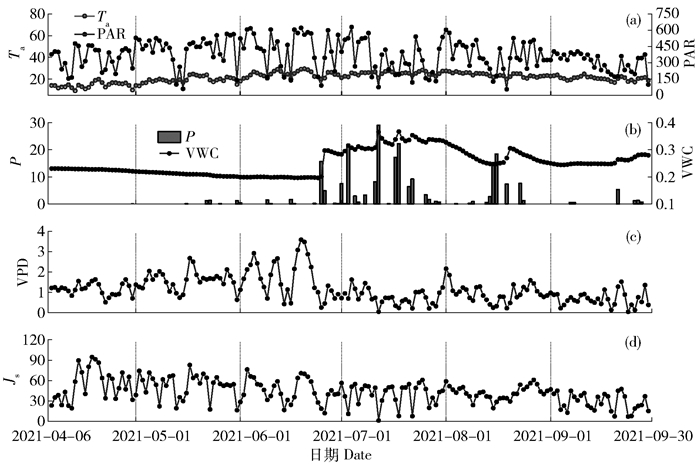
|
Ta,空气温度,℃;PAR,光合有效辐射,μmol/(m2·s);VWC,土壤体积含水量,m3/m3;P:降雨量,mm;VPD:蒸气压差,kPa;Jsd,日平均液流速率,g/(cm2·d)。下同。 Ta, air temperature, ℃; PAR, photosynthetically active radiation, μmol/(m2·s); VWC, volumetric soil water content, m3/m3; P, precipitation, mm; (P); VPD, vapor pressure deficit, kPa; Jsd, daily average of sap flow density, g/(cm2·d). The same below. 图 2 黄栌树干液流速率(Jsd)与环境因子的动态变化 Fig. 2 Variations in sap flow density (Jsd) of Cotinus coggygria and environmental factors |
昼夜尺度,Jsd从太阳升起开始增加,在每天11:00—14:00之间达到峰值,随后下降,最低值在23:00—次日04:00之间(图 3a);PAR的日变化趋势与Js一致,而Ta、VPD呈先小幅下降后上升,在15:00—16:00达到峰值,随后开始下降,在次日4:00—6:00之间开始上升(图 3b~d)
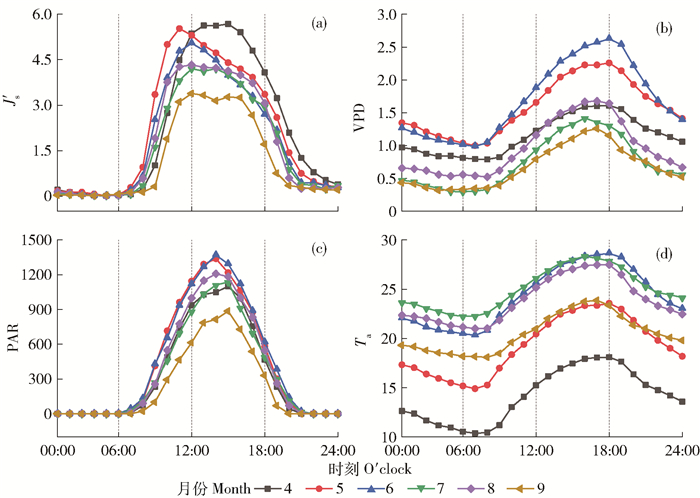
|
Js′:液流速率,g/(cm2·s)。下同。 Js′: sap flow density, g/(cm2·s). The same below. 图 3 4—9月液流速率(Js′)及环境因子的昼夜变化 Fig. 3 Diurnal variation in sap flow density(Js′) and environmental factors from April to September |
季节尺度,对Jsd与环境因子进行通径分析,结果如表 2,可以看出:Jsd与VPD和PAR之间表现为较大的显著相关性,相关系数分别为0.649与0.527,并而与VPD之间的直接通径系数最大,数值为为0.8,其次为gs,数值为0.5,而与PAR之间的直接通径系数较小(表 2);由间接通径系数可以看出,VPD与PAR之间的相关系数也较大,表明辐射会影响空气温度和湿度,从而间接地影响VPD。
| 表 2 季节尺度黄栌液日平均流速率(Jsd)对环境因子的响应 Tab. 2 Responses of daily average of sap flow density (Jsd) of Cotinus coggygria to environmental factors on the seasonal scale |
蒸气压差通过调控气孔导度来调节液流,做液流速率Js′与gs随VPD变化图(图 4),可以看出:VPD < 1.5 kPa时,Js′与VPD显著线性正相关(R2=0.95),但gs与VPD无线性关系且此时gs数值处于较高水平;VPD>1.5 kPa时,gs与VPD呈指数型下降(R2=0.84),此时Js′与VPD相关性较差。通过分析VPD处于1.5 kPa上下时Js′与gs的相关性,可以看出VPD>1.5 kPa时,gs对Js的调控作用更强,表现为显著性正相关(R2=0.88)(图 5)。因此,蒸气压差对液流的调控表现为:VPD < 1.5 kPa时,VPD直接调控Js′;VPD>1.5 kPa时,VPD抑制gs,对Js′的调控作用逐渐减弱。在生长旺期(6—8月),Jsd与VPD、Ta、PAR的线性相关关系均显著,分别解释了Js变化的94%、87%和79%,但与VWC无明显关系(图 6a~d)。
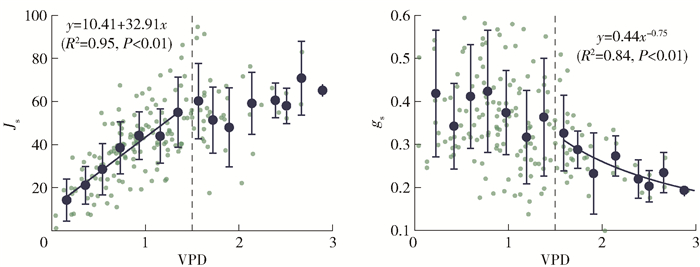
|
gs,气孔导度,mol/(m2·s);半小时Js′、gs数据按0.2 kPa VPD分段平均。误差棒代表标准差,下同。 gs, stomatal conductance, mol/(m2·s); Both of half-hourly Js′ and half-hourly gs were bin-averaged with the increment of VPD by 0.2 kPa. Bars indicate standard errors. The same below. 图 4 液流速率(Js′)和气孔导度(gs)与蒸气压差(VPD)的关系 Fig. 4 Relationship between sap flow density (Js′) or stomatal conductance(gs) and vapor pressure deficit (VPD) |
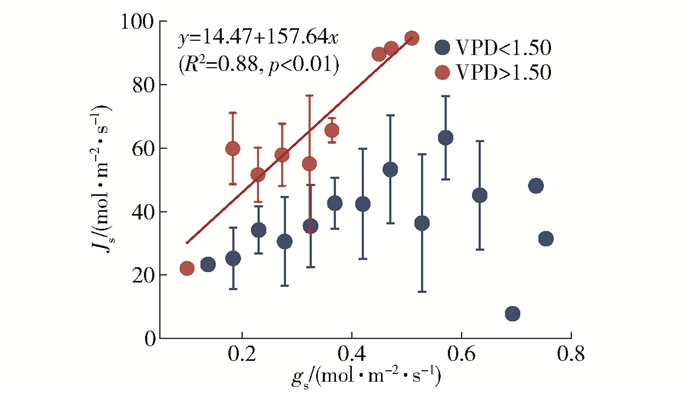
|
半小时Js数据按0.05 mol/(m2·s) gs分段平均。 Half-hourly Js was bin-averaged with the increment of gs by 0.05 mol/(m2·s). 图 5 液流速率(Js)与气孔导度(gs)的关系 Fig. 5 Relationship between sap flow density (Js) and stomatal conductance(gs) |
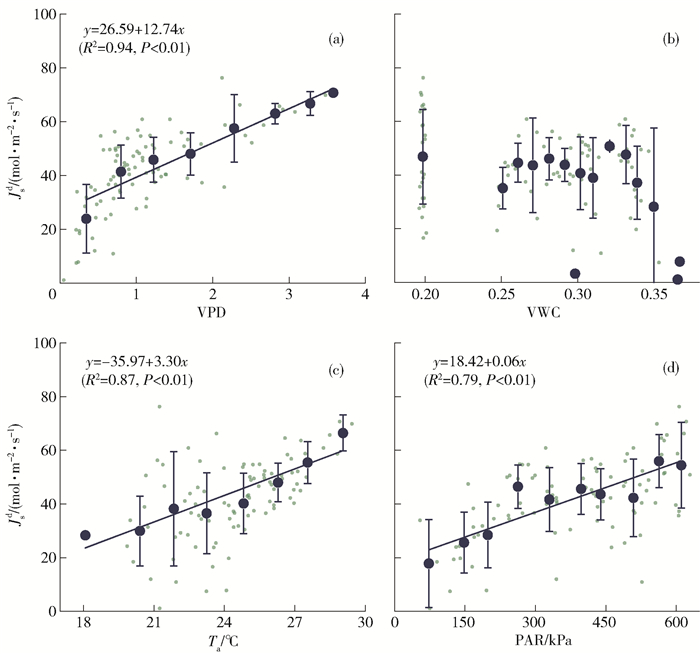
|
Jsd数据分别按0.5 kPa VPD、0.008 m3/m3 VWC、1.5 ℃ Ta、60 μmol/(m2·s) PAR分段平均。 Jsd is bin-averaged with the increment of VPD, VWC, Ta and PAR by 0.5 kPa, 0.008 m3/m3, 1.5 ℃ and 60 μmol/(m2·s). 图 6 生长旺期(6—8月)日平均液流速率(Jsd)与环境因子的关系 Fig. 6 Relationship between daily average of sap flow density (Jsd) and environmental factors during the mid-growing season from June to August |
昼夜尺度Js′与环境因子之间存在时滞(图 3)。Js′与环境因子在不同月份时滞时间如表 3,结果如下:4—9月,Js′整体滞前于Ta、VPD,但在7月时滞减弱;Js′与PAR在不同月份存在0.5 h的时滞或没有时滞(表 3);对Js′与环境因子进行时滞校正,校正后的Js′与Ta、PAR、VPD的相关程度均提高(表 4),其R2均值分别从0.544、0.92、0.54升至0.863、0.94、0.86,其中Js′与PAR之间的线性相关系数最大。
| 表 3 不同环境因子与树干液流(Js)的时滞时间 Tab. 3 Time lags between sap flow (Js) and different environmental factors |
| 表 4 时滞校正对树干液流速率(Js′)与环境因子线性相关的影响 Tab. 4 Influences of time lag revision on the linear relations between sap flow density (Js′) and environmental factors |
校正后Js′在白天(8:00~20:00)对环境变量的敏感性不同(图 7)。Js′—Ta、Js′—PAR、Js′—VPD、Js′—Ta之间的回归斜率在上午11:00之前较大,在中午和下午早些时候(12:00—16:00)较低,傍晚(17:00—20:00)Js′—Ta、Js′—VPD敏感性持续降低,但Js′—PAR回归斜率呈逐渐上升趋势。

|
图 7 08:00—20:00液流速率(Js′)与环境因子之间的线性回归斜率 Fig. 7 Linear regression slopes between sap flow density (Js′) and environmental factors from 08:00 to 20:00 |
季节尺度VPD和PAR共同调控Jsd的变化,这一结果在其他研究中也有发现[16, 18]。其中,VPD调控作用更强,蒸气压差通过影响植被气孔导度调控液流变化[16, 38],调控机制为:当VPD < 1.5 kPa时,气孔处于张开状态,gs较大,VPD直接控制液流;当VPD>1.5 kPa时,gs随VPD的上升而下降(图 4),气孔逐渐关闭,VPD对液流的调控作用逐渐减弱。PAR与VPD共同调控液流,PAR作为初始能量,是植物进行水汽交换的主要驱动力,对VPD有着极强的调控作用。有研究发现,蒸气压差和太阳辐射对树干液流的影响与土壤含水量密切相关,土壤含水量相对充足时,蒸气压差为主要调控因子,反之为太阳辐射[39]。本研究中土壤含水量充足,且Jsd主要受VPD调控,与该研究结果一致, 更加论证这一观点。
同一地区处于不同生长阶段的相同树种,其液流变化也有所不同[16]。生长旺期(6—8月)叶片气孔导度较大,蒸腾较强,此时液流主要受环境因子的综合调控(图 6)。这与科尔沁沙地杨树树干液流的研究结果一致[17],环境因子通过影响植物叶片气孔的开闭来促进或抑制植物蒸腾[6, 16, 40-41]。本研究中Jsd与VWC无明显关系,说明季节尺度土壤含水量并不是黄栌液流的限制因子。
4.2 昼夜尺度上环境因子对液流的调控本研究发现,液流昼夜变化整体表现为单峰曲线(图 3),在其他研究中也有类似的发现[16, 19, 22]。峰值时间出现在正午左右,说明高温环境下,植物会降低气孔导度,减少蒸腾,来适应高温环境胁迫[36-37];但在不同月份达到峰值的具体时间存在差异,4月液流峰值出现时间明显晚于其他月份(图 3)。这是由于4月叶片气孔尚未完全张开,气孔导度较小,增加蒸腾时间,使其延后到达峰值[18, 20]。
液流的昼夜变化与环境因子显著相关[42]。本研究中,昼夜尺度Js主要受PAR控制,PAR作为初始能量,促使Ta和VPD增大,造成Js′与PAR、Ta、VPD三者到达峰值的时间存在相位差,因此,PAR是液流与环境因子昼夜变化产生时滞现象的主要因子。Js′对Ta、PAR和VPD的响应存在时滞(表 3),对时滞进行校正后发现Js′与环境因子之间的相关性均有提高,说明校正可以显著提高树干液流与环境因子的相关性[43];且时滞校正后液流仍与PAR的相关性最大(表 4),再次验证辐射为树干液流昼夜变化的主要影响因素。液流与环境因子之间的时滞现象体现植物对环境胁迫的高度适应,由于气孔导度直接影响植物流体流动速率[16, 44],液流与环境之间出现时滞本质上就是气孔导度在不同月份对环境响应的差异。
高温会抑制植物的生理活动并降低气孔导度,为适应夏季正午高温的外界环境,减少水分损失,植物会提前关闭部分气孔,减少蒸腾[36-37]。本研究中,在正午之前,随着时间的推移Js对PAR、VPD、Ta的回归斜率逐渐降低(图 7),到正午趋近于0,表明在较为干热的条件下,液流对环境因子变化的敏感性降低。
5 结论本研究发现黄栌树干液流昼夜变化主要受光合有效辐射(PAR)控制,季节尺度主要受蒸气压差(VPD)调控。黄栌具有低耗水特性,其树干液流对环境敏感性的差异以及对环境因子的时滞效应充分反映黄栌的环境适应性,为北京山区营造水土保持林选取主要造林树种提供了更科学的理论依据。但本研究中黄栌具有低耗水性,样地土壤水分充足,无法确定该树种对土壤水分需求的阈值,需要进一步结合较为干旱地区对于黄栌耗水特性的研究。
| [1] |
郭勇, 林超, 李文君, 等. 海河流域水资源与水环境演变过程初探[C]//2012中国环境科学学会学术年会论文集(第二卷). 北京: 中国农业大学出版社, 2012: 300. GUO Yong, LIN Chao, LI Wenjun, et al. Preliminary study of the evolution of water resources and water environment in the Haihe river basin[C]//Proceedings of the 2012 Annual Symposium of the Chinese Society for Environmental Science (Volume Ⅱ). Beijing: China Agricultural University Press, 2012: 300. |
| [2] |
李思静, 查天山, 秦树高, 等. 油蒿茎流动态及其环境控制因子[J]. 生态学杂志, 2014, 33(1): 112. LI Sijing, ZHA Tianshan, QIN Shugao, et al. Temporal patterns and environmental controls of sap flow in Artemisia ordosica[J]. Chinese Journal of Ecology, 2014, 33(1): 112. |
| [3] |
李新宇, 李延明, 孙林, 等. 银杏蒸腾耗水与环境因子的关系研究[J]. 北京林业大学学报, 2014, 36(4): 23. LI Xinyu, LI Yanming, SUN Lin, et al. Characteristics of transpiration water consumption and its relationship with environmental factors in Ginkgo biloba[J]. Journal of Beijing Forestry University, 2014, 36(4): 23. |
| [4] |
SUN Shoujia, MENG Ping, ZHANG Jinsong, et al. Partitioning oak woodland evapotranspiration in the rocky mountainous area of North China was disturbed by foreign vapor, as estimated based on non-steady-state 18O isotopic composition[J]. Agricultural and Forest Meteorology, 2014, 184: 36. DOI:10.1016/j.agrformet.2013.08.006 |
| [5] |
任启文, 毕君, 李联地, 等. 冀北山地白桦全生长季树干液流特征[J]. 干旱区资源与环境, 2017, 31(11): 169. REN Qiwen, BI Jun, LI Liandi, et al. Stem sap flow characteristic of Betula platyphylla during growth season in northern mountain areas of Hebei province[J]. Journal of Arid Land Resources and Environment, 2017, 31(11): 169. |
| [6] |
辛福梅, 闫小莉, 张长耀, 等. 西藏拉萨河谷区藏川杨和北京杨树干液流特征及其对环境因子的响应[J]. 林业科学, 2019, 55(2): 22. XIN Fumei, YAN Xiaoli, ZHANG Changyao, et al. Characteristics of stem sap flow of two poplar species and their responses to environmental factors in Lhasa River Valley of Tibet[J]. Scientia Silvae Sinicae, 2019, 55(2): 22. |
| [7] |
马玉洁, 李春友, 武鹏飞, 等. 基于实测白榆蒸腾速率校正计算液流速率的Granier原始公式[J]. 林业科学, 2020, 56(6): 179. MA Yujie, LI Chunyou, WU Pengfei, et al. Correction of Granier's original formula coefficient for calculating sap flow based on the measured transpiration rate of Ulmus pumila[J]. Scientia Silvae Sinicae, 2020, 56(6): 179. |
| [8] |
马长明, 张含含, 韩煜, 等. Granier原始公式测算107杨树干液流通量密度的误差及校正公式[J]. 林业科学, 2021, 57(3): 161. MA Changming, ZHANG Hanhan, HAN Yu, et al. Error and correction formula of Granier's original formula to calculate the stem sap flux density of clone 107 poplar[J]. Scientia Silvae Sinicae, 2021, 57(3): 161. |
| [9] |
郝少荣, 裴志永, 段广东, 等. 不同时间尺度下环境因子与沙柳茎流关系的差异研究[J]. 干旱区资源与环境, 2020, 34(3): 152. HAO Shaorong, PEI Yongzhi, Duan Guangdong, et al. Relationships between environmental factors and Salix psammophila's sap flow at different time scales[J]. Journal of Arid Land Resources and Environment, 2020, 34(3): 152. |
| [10] |
TIE Qiang, HU Hongchang, TIAN Fuqiang, et al. Environmental and physiological controls on sap flow in a subhumid mountainous catchment in North China[J]. Agricultural and Forest Meteorology, 2017, 240: 46. |
| [11] |
铁强. 华北土石山区林地蒸散发机理研究[D]. 北京: 清华大学, 2018: 8. TIE Qiang. Mechanism research on the forest evapotranspiration in the Earth-Rock Mixed Mountainous Region of North China[D]. Beijing: Tsinghua University, 2018: 8. |
| [12] |
NOVICK A K, FICKLIN L D, STOY C P, et al. The increasing importance of atmospheric demand for ecosystem water and carbon fluxes[J]. Nature Climate Change, 2016, 6(11): 1023. DOI:10.1038/nclimate3114 |
| [13] |
韩春, 陈宁, 孙杉, 等. 森林生态系统水文调节功能及机制研究进展[J]. 生态学杂志, 2019, 38(7): 2191. HAN Chun, CHEN Ning, SUN Shan, et al. A review on hydrological mediating functions and mechanisms in forest ecosystems[J]. Chinese Journal of Ecology, 2019, 38(7): 2191. |
| [14] |
JIAO Lei, LU Nan, FANG Weiwei, et al. Determining the independent impact of soil water on forest transpiration: A case study of a black locust plantation in the Loess Plateau, China[J]. Journal of Hydrology, 2019, 572: 671. DOI:10.1016/j.jhydrol.2019.03.045 |
| [15] |
孙旭, 杨文慧, 焦磊, 等. 不同时间尺度北京蟒山油松树干液流对环境因子的响应[J]. 生态学报, 2022, 42(10): 4113. SUN Xu, YANG Wenhui, JIAO Lei, et al. Relationships between sapflux density of Pinus tabuliformis trees and environmental factors at different temporal scales in Mangshan National Forest Park of Beijing, China[J]. Scientia Silvae Sinicae, 2022, 42(10): 4113. |
| [16] |
张凯, 孙艳丽, 隗骥超, 等. 北京山区大果榆树干液流的季节与昼夜环境调控[J]. 林业科学, 2023, 59(7): 24. ZHANG Kai, SUN Yanli, KUI Jichao, et al. Control of environmental factors on the sap flow at daily and seasonal scales in Ulmus macrocarpa in Beijing, China[J]. Scientia Silvae Sinicae, 2023, 59(7): 24. |
| [17] |
贾天宇, 刘廷玺, 段利民, 等. 半干旱沙丘草甸过渡带人工杨树蒸腾耗水规律[J]. 生态学杂志, 2020, 39(10): 3255. JIA Tianyu, LIU Tingxi, DUAN Limin, et al. Transpiration and water consumption of poplar trees in semi-arid dune meadow transition zone[J]. Chinese Journal of Ecology, 2020, 39(10): 3255. |
| [18] |
林琳, 蔡国军, 莫保儒, 等. 半干旱黄土区山毛桃树干液流变化特征及其与环境因子的相关分析[J]. 西北林学院学报, 2023, 38(4): 18. LIN Lin, CAI Guojun, MO Baoru, et al. Characteristics of sap flow and correlation analysis with environmental factors of Prunus davidiana in semiarid loess area[J]. Journal of Northwest Forestry University, 2023, 38(4): 18. |
| [19] |
党宏忠, 张劲松, 赵雨森. 应用热扩散技术对柠条锦鸡儿主根液流速率的研究[J]. 林业科学, 2010, 46(3): 29. DANG Hongzhong, ZHANG Jinsong, ZHAO Yusen. Application of the thermal dissipation probe technique in studying the sap flow in taproot of Caragana korshinskii[J]. Scientia Silvae Sinicae, 2010, 46(3): 29. |
| [20] |
李海龙, 李端亮. 黄栌属植物研究进展[J]. 陕西林业科技, 2009(6): 22. LI Hailong, LI Duanliang. Advances in studies on genus Cotinus(Tourn·) Mill[J]. Shaanxi Forest Science and Technology, 2009(6): 22. |
| [21] |
刘春鹏, 翟明普, 马长明, 等. 华北石质山区4种乡土树种耗水特征[J]. 东北林业大学学报, 2010, 38(7): 29. LIU Chunpeng, ZHAI Mingpu, MA Changming, et al. Water consumption characteristics of four native tree species in the rocky mountain area of North China[J]. Journal of Northeast Forestry University, 2010, 38(7): 29. |
| [22] |
周平, 李吉跃, 招礼军. 北方主要造林树种苗木蒸腾耗水特性研究[J]. 北京林业大学学报, 2002, 24(5/6): 50. ZHOU Ping, LI Jiyue, ZHAO Lijun. Characteristics of seedlings water consumption by transpiration of main afforestation tree species in north China[J]. Journal of Beijing Forestry University, 2002, 24(5/6): 50. |
| [23] |
杨新兵. 华北土石山区典型人工林优势树种及群落耗水规律研究[D]. 北京: 北京林业大学, 2007: 29. YANG Xinbing. Study on the rules of water consumption of dominant tree species and the community of artificial forest in Mountain Area of northern China[D]. Beijing: Beijing Forestry University, 2007: 29. |
| [24] |
王瑞辉, 马履一. 北京15种园林树木耗水性的比较研究[J]. 中南林业科技大学学报, 2009, 29(4): 16. WANG Ruihui, MA Lüyi. Comparative research of water consumption from 15 garden tree species in Beijing[J]. Journal of Central South University of Forestry & Technology, 2009, 29(4): 16. |
| [25] |
何春霞, 张劲松, 孟平, 等. 太行山南麓3种常见灌木的水分利用特性[J]. 林业科学, 2018, 54(9): 137. HE Chunxia, ZHANG Jinsong, MENG Ping, et al. Water use strategies of three native shrubs in the southern Taihang Mountain[J]. Scientia Silvae Sinicae, 2018, 54(9): 137. |
| [26] |
GRANIER A. Evaluation of transpiration in a Douglas-fir stand by means of sap flow measurements[J]. Tree Physiology, 1987, 3(4): 309. DOI:10.1093/treephys/3.4.309 |
| [27] |
GRANIER A, BIRON P, LEMOINE D. Water balance, transpiration and canopy conductance in two beech stands[J]. Agricultural and Forest Meteorology, 2000, 100(4): 291. DOI:10.1016/S0168-1923(99)00151-3 |
| [28] |
RICHARD P L, PATRICK F, DAVID F C, et al. Quantification of uncertainties in conifer sap flow measured with the thermal dissipation method[J]. The New phytologist, 2018, 219(4): 1283. DOI:10.1111/nph.15241 |
| [29] |
李鑫豪, 田文东, 李润东, 等. 北京松山落叶阔叶林生态系统水热通量对环境因子的响应[J]. 植物生态学报, 2021, 45(11): 1191. LI Xinhao, TIAN Wendong, LI Rundong, et al. Responses of water vapor and heat fluxes to environmental factors in a deciduous broadleaved forest ecosystem in Beijing[J]. Chinese Journal of Plant Ecology, 2021, 45(11): 1191. |
| [30] |
REICHSTEIN M, FALGE E, BALDOCCHI D, et al. On the separation of net ecosystem exchange into assimilation and ecosystem respiration: Review and improved algorithm[J]. Global Change Biology, 2005, 11(9): 1424. DOI:10.1111/j.1365-2486.2005.001002.x |
| [31] |
CLEARWATER M J, MEINZER F C, ANDRADE J L, et al. Potential errors in measurement of nonuniform sap flow using heat dissipation probes[J]. Tree Physiology, 1999, 19(10): 681. DOI:10.1093/treephys/19.10.681 |
| [32] |
LU Ping, URBAN L, ZHAO Ping. Granier's thermal dissipation probe (TDP) method for measuring sap flow in trees: Theory and practice[J]. Acta Botanica Sinica, 2004, 46(6): 631. |
| [33] |
温杰, 陈云明, 唐亚坤, 等. 黄土丘陵区油松、沙棘生长旺盛期树干液流密度特征及其影响因素[J]. 应用生态学报, 2017, 28(3): 763. WEN Jie, CHEN Yunming, TANG Yakun, et al. Characteristics and affecting factors of sap flow density of Pinus tabuliformis and Hippophae rhamnoides in growing season in the hilly region of the Loess Plateau, China[J]. Chinese Journal of Applied Ecology, 2017, 28(3): 763. |
| [34] |
BRITO P, LORENZO R J, GONZÁLEZ-RODRÍGUEZ M Á, et al. Canopy transpiration of a semi arid Pinus canariensis forest at a treeline ecotone in two hydrologically contrasting years[J]. Agricultural and Forest Meteorology, 2015, 201: 120. |
| [35] |
WANG Ben, ZHA Tianshan, JIA Xin, et al. Soil moisture modifies the response of soil respiration to temperature in a desert shrub ecosystem[J]. Biogeosciences, 2014, 11(2): 259. DOI:10.5194/bg-11-259-2014 |
| [36] |
ZHA Tianshan, QIAN Duo, JIA Xin, et al. Soil moisture control of sap-flow response to biophysical factors in a desert-shrub species, Artemisia ordosica[J]. Biogeosciences, 2017, 14(19): 4533. DOI:10.5194/bg-14-4533-2017 |
| [37] |
HAYAT M, ZHA Tianshan, JIA Xin, et al. A multiple-temporal scale analysis of biophysical control of sap flow in Salix psammophila growing in a semiarid shrubland ecosystem of northwest China[J]. Agricultural and Forest Meteorology, 2020, 288. |
| [38] |
BALDOCCHI D D, WILSON K B, GU Lianhong. How the environment, canopy structure and canopy physiological functioning influence carbon, water and energy fluxes of a temperate broad-leaved deciduous forest: An assessment with the biophysical model CANOAK[J]. Tree Physiology, 2002, 22(15/16): 1065. |
| [39] |
许庭毓, 牛香, 王兵, 等. 不同土壤水分条件下杉木种源树干液流特征对气象因子的响应[J]. 中国水土保持科学, 2023, 21(5): 99. XU Tingyu, NIU Xiang, WANG Bing, et al. Responses of sap flow characteristics under different Chinese fir provenances to meteorological factors under different soil moisture conditions[J]. Science of Soil and Water Conservation, 2023, 21(5): 99. DOI:10.16843/j.sswc.2023.05.011 |
| [40] |
OUYANG Zutao, CHEN Jiquan, BECKER R, et al. Disentangling the confounding effects of PAR and air temperature on net ecosystem exchange at multiple time scales[J]. Ecological Complexity, 2014, 19(9): 46. |
| [41] |
韩辉, 张学利, 党宏忠, 等. 科尔沁沙地南缘樟子松林蒸腾强度的年际变化及与降水、地下水位间的关系[J]. 林业科学, 2020, 56(11): 31. HAN Hui, ZHANG Xueli, DANG Hongzhong, et al. Inter-annual variation of transpiration intensity of Pinus sylvestris var. mongolica stand on the southern margin of Horqin Sandy Land and its relationship with precipitation and groundwater level[J]. Scientia Silvae Sinicae, 2020, 56(11): 31. |
| [42] |
IQBAL S, ZHA Tianshan, JIA Xin, et al. Interannual variation in sap flow response in three xeric shrub species to periodic drought[J]. Agricultural and Forest Meteorology, 2021, 297(4): 108276. |
| [43] |
王慧梅, 孙伟, 祖元刚, 等. 不同环境因子对兴安落叶松树干液流的时滞效应复杂性及其综合影响[J]. 应用生态学报, 2011, 22(12): 3109. WANG Huimei, SUN Wei, ZU Yuangang, et al. Complexity and its integrative effects of the time lags of environment factors affecting Larix gmelinii stem sap flow[J]. Chinese Journal of Applied Ecology, 2011, 22(12): 3109. |
| [44] |
MATHENY A M, BOHRER G, VOGEL C S, et al. Species-specific transpiration responses to intermediate disturbance in a northern hardwood forest[J]. Journal of Geophysical Research-Biogeosciences, 2014, 119(12): 2292. |